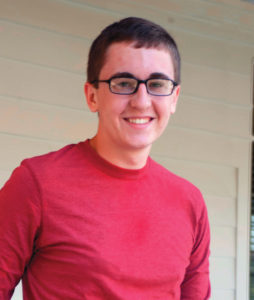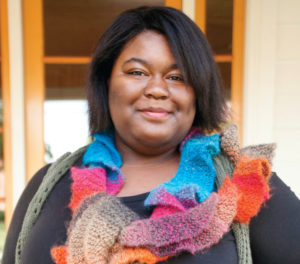
Carl Craft, ’17
Carl Craft is an 18 year old from the small town of Greenup in eastern Kentucky, where the Little Sandy River meets Ohio. Some of his friends are already Berea College students and he has already come to love the community, which he finds “a very open-minded place.”
A Bonner Scholar at Berea, Carl is compassionate and hard working. He is considering nursing for a career and is excited about getting to know new people and having new experiences.
“I want to discover myself and what I want for myself and my life. I want to network and meet great people. I want to be the best version of myself that I can be,” said Carl.

Destiny Askew, ’17
Destiny Askew is an 18 year old from Birmingham, Alabama. Berea College came on her radar through a positive family recommendation. Her cousin, Andrew Stanberry, ’94, and his wife Cleo, ’95, “talked about Berea all the time” and urged Destiny to consider their alma mater.
During her junior year of high school, she visited Berea for the first time during the Carter G. Woodson weekend. “I came back thinking Berea was in the middle of nowhere, and I didn’t want to go there. Then I visited a lot of colleges my senior year. I then realized that most of them were in the middle of nowhere and those that were in big cities were kind of scary,” said Destiny.
After sitting in on a couple of classes during another visit, she decided Berea was the “best fit” for her. The academic standout was honored at her high school for giving 342 hours of community service to the underprivileged. In the future, Destiny hopes to get a degree in psychology and use it to work with children dealing with chronic disease or coping with learning disabilities.
A father and his daughter from eastern Kentucky sat at a table in admissions director Luke Hodson’s, ’02, office several months ago. The excited young woman had recently been accepted for the fall semester at Berea College, and her dad was speechless. An impossible dream was coming true.
“He became emotional because he’d told her they wouldn’t be able to afford college,” remembered Hodson. There were tears in the father’s eyes when the reality began to dawn on him that his daughter was going to have the opportunity to earn a college education and it wouldn’t be the financial burden he’d feared.
“When you see that sigh of relief from parents and that understanding that it’s going to be OK. For me, that just makes it real. That is why Berea is doing what it is doing. It is reassuring and refreshing,” said Hodson.
Perhaps more than at any other place on campus, the Admissions Office is where the Great Commitments of Berea College drive every decision. These decisions are matched to six guiding principles derived from the College’s strategic document Being and Becoming. These principles are the academic promise, financial need, coeducation, interracial education, commitment to Appalachia, and service.
Regarding academic promise, the counselors look beyond traditional academic measures like test scores and GPA to assess academic readiness. The student’s academic initiative and persistence are also considered. Written endorsements (formerly referred to as recommendations) are required and closely scrutinized. Prospective students also participate in a formal interview, spending 20-30 minutes with an admissions counselor. Though no longer required, many applicants also submit written essays, explaining their personal stories and emphasizing the reasons why they desire a Berea College education. This year the approach resulted in an incoming class whose academic promise is illustrated by an average ACT score of 24.3 and a high school GPA of 3.42
The need for help with the cost of a college education is tremendous—especially for incoming Berea College students, 60 percent of whom have an expected family contribution of $0. Over 95 percent of Berea students qualify for Pell Grants and the average household income of the student body is approximately $26,000. In fact, having a family income that is too high prevents many individuals from attending. Parents sometimes ask if they can just pay the tuition so their child can attend, but it is never allowed. “You can’t buy your way in,” Hodson said.
The first coeducational college in Kentucky to welcome female students, the College remains committed to coeducation. However, over the past few decades, this has meant making sure that enough males are part of the equation. This is a national trend, according to Hodson. Many colleges have incoming classes that are just 40 percent male, but Berea College recruiters work hard to better this statistic, and the percentage is 46 percent male, 54 percent female.
Berea actively recruits students of different races, dedicated to keeping a diverse population. Eighteen percent of the student body is African American, with 20% of incoming freshman identifying as “Black or African American” alone or in combination with another race. Between five and seven percent, or approximately 30 students, of each class, is made up of international students. According to Hodson, the largest number of international applications comes from Africa because of the tremendous need there. This year’s freshman class includes students from Afghanistan, China, Ethiopia, Greece, Honduras, and 20 other countries.
The College’s commitment to Appalachia continues with 79% of the new freshman class coming from Berea’s “in-territory.” This includes all of Kentucky and much of the Appalachian region, including counties in West Virginia, Ohio, Virginia, Tennessee, North Carolina, South Carolina, Georgia, and Alabama.
Students who seek opportunities to help people in their communities and around the world make Berea College recruiters sit up and take notice. Freshmen such as Carl Craft of Greenup, Kentucky, who volunteered in Haiti, or Destiny Askew, of Birmingham, Alabama, who made community service integral to her life, fit right in with the College’s self-identified commitment to service.
The 397 freshman and 42 transfer students who entered the College community in August were selected from 1,620 and 145 completed applications respectively. This resulted in a freshman acceptance rate of 34% and a transfer acceptance rate of 35%. These are students whose academic abilities that might have gone untapped due to economic factors.
Many students who would make ideal Berea students don’t even bother applying or completing the application process because they consider supporting their family or making an income as the most immediate and important need, Hodson indicated.
“One of the most challenging parts of our job is helping students see the benefits of college and the benefits of a Berea College education. It is only through the committed admissions staff that we’re able to get the promising students in each year,” he explained.
Hodson, a Berea alum, is thrilled each year to see the new, eager freshman faces. “What gets me excited is the opportunity of change for these students and for generations to come in their families. The decisions we make are investments on behalf of the College. These students are not here by mistake but rather because we see someone with promise who can take advantage of the opportunities we offer.”

